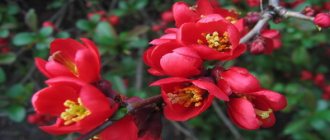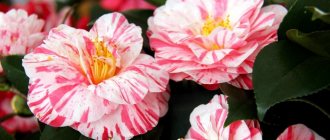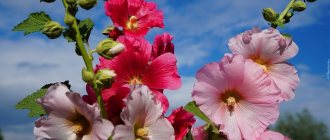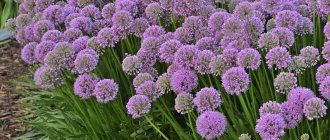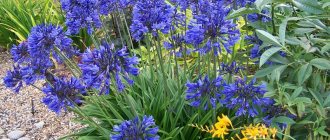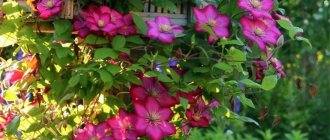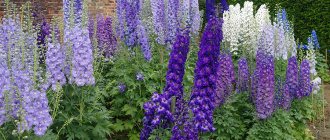Japanese anemone (A. hupehensis or A. japonica), commonly called anemone, Japanese anemone, or foxglove, is a group of herbaceous perennial plants in the buttercup family (Ranunculaceae). They are all the result of crosses between two or three species, A. hupehensis, A. vitifolium and A. tomentosa, which are actually native to China, but were erroneously called Japanese anemones due to an early record of one plant from Japan.
Towering above golden fall flower beds on long, thin, wiry stems, this anemone hints at winter with pure white or pale pink flowers and offers welcome relief from the fading hot colors of summer.
Some varieties
- Pamina is an early flowering plant, sometimes reaching 90 cm in height. It begins to bloom in July. The flowers are burgundy or sometimes a very dark red. This variety is very popular in flower beds and flower beds, for the reason that it requires almost no care.
- Profuzhn is a hybrid variety. Its flowers are purple double, and the flowering period is from late summer until October. It is believed that this breed is autumnal. Like many hybrids, this anemone is quite tall. Its bushes sometimes grow up to 1.2 m.
- WilWind differs from others in its decorative basal leaves with a serrated edge. The flowers are white or yellow with many stamens and form inflorescences of 10-15 each. It blooms, like the previous variety, at the end of summer.
- Prince Henry is a bush with beautiful leaves. It is similar to WilWind, but its flowers are bright red. This plant blooms in the same way as the previous variety, from the end of summer.
- Queen Charlotte attracts gardeners with its three-lobed leaves and large double light pink flowers.
- The September Charm variety is translated as “the charm of September.” This plant has large, bright leaves of the same shape as the previous variety, but differs in its delicate pinkish-colored flowers. It naturally blooms in late August – September.
Care for each variety is almost the same.
Japanese anemone in landscape design
Autumn anemones grow quite tall, except for some new varieties. They look great as a tapeworm, focal plant and as part of woody landscape groups. Anemone can be planted in a flower bed along with other perennials of suitable growth, as a high border or along the perimeter of a fence, gazebo or outbuilding.
Japanese anemone goes well with the following plants:
- large hosts;
- ferns;
- any conifers;
- remontant roses with bright flowers;
- Shrubs and trees changing leaf color by the end of the season.
Anemone species
Today there are more than 150 different species, but our climatic zones accept the following most popular varieties:
Crown anemone
It is deservedly considered its species and the most common specimen. A very beautiful plant, reaching more than 40 cm in height. It has a sparsely haired and erect stem, turning into a rather large (about 9 cm) flower. It has a poppy-like shape with velvety stamens. Thanks to the huge palette, you can choose a plant for any garden.
Anemone de caen
Also quite a famous representative is the anemone. The flowering of this wonderful flower begins in the first days of summer, but after the onset of the first heat the foliage falls off. As soon as the roots feel the autumn coolness, they immediately send out new shoots and again delight with beautiful flowering. The stem is quite stable and erect, reaching a height of 50 to 85 cm, the flowers are single, with an incredible range of colors.
Anemone autumn
A group of flowers whose flowering begins at the end of summer and continues until mid-autumn. Beautiful and large perennial plants with very tall peduncles (from 80 to 150 cm). Different varieties can have from a couple to several dozen full flowers. They can be terry, semi-double or ordinary. Autumn anemone will bring bright colors to your garden during this gloomy period.
Japanese anemone
Another variant of a hybrid that blooms in autumn. It has a rather tall and strong stem, up to 1.5 m. Large leaves have the shape of a dissected feather and are dark green in color. Flowers are large in size, with double or regular texture. Presented in white, sometimes pink shades with a golden center, they germinate in late August or early September.
Forest anemone
Quite different from previous varieties. It is not a very tall plant (about 20–30 cm) with fairly large flowers. Flowering begins in late May or early July and lasts about 15–20 days.
Oak anemone
An extremely unpretentious and tenacious variety of anemone. The height reaches approximately 20–30 cm, has white peduncles (which is why the alternative name is White Anemone) with a diameter of 2 to 3.5 cm. Thanks to breeders, today you can find pink, blue or lilac hybrids.
Terry anemone
A beautiful decorative anemone that blooms for a rather long period compared to other types of flowers. It is preferable to plant in groups, as well as to create rockeries or alpine slides.
Description of the plant
Japanese anemone is a beautiful shrub with three-lobed, jagged leaves and colorful flowers that grow singly or in clumps on smooth stems. Anemones begin to bloom in the second half of summer.
Species crops can grow up to 80 cm, there are hybrids lower - 70 cm, and some higher - 120-135 cm.
The standard leaf color is gray-green; in hybrids, the leaves have a bluish or silver tone.
The plant, which lives in its natural environment, has simple flowers that are arranged in groups on the stem. They are painted in light colors - white or pink. Garden flowers have a wide range of colors and fullness.
Anemone in the garden
Caring for Japanese anemone
As practice shows, a distinctive feature of culture is unpretentiousness in care, and this is undoubtedly true. In order to see the beauty of plants in full force, you will need to provide proper care, namely, irrigate the soil in a timely manner, apply fertilizers at least 3 times during the season, remove weeds, loosen and mulch the soil.
Watering
A distinctive feature of the crop is its minimal watering requirements. In the spring, irrigation should be carried out once every 7 days and only if there has been no precipitation for a long period of time. In hot summers, watering should be more frequent, but in small quantities.
It is important to understand that the root system is located in the upper layers, as a result of which moisture loss occurs as quickly as possible; in addition, the roots cannot take moisture from the lower layers
Important! It is not recommended to loosen the soil in close proximity to Japanese Anemone; it is recommended to mulch the soil
Top dressing
Often the Japanese Anemone flower grows without fertilizing, as a result of which it is impossible to see the crop in all its glory. It is recommended to apply fertilizer at least 3 times during the season:
- In spring, when the first green leaves begin to appear. In this case, organic is perfect.
- During the formation of the first buds, mineral complex fertilizers are applied.
- In the second half of September, any type of fertilizer that does not contain nitrogen is applied.
This is the only way to see all the beauty of flowers.
Shelter for the winter
In the southern regions, the crop does not need shelter. All that is required is simply to cover the plants with a thin layer of mullein
This approach is more of a precautionary measure and also allows you to avoid applying the first fertilizing
In regions with harsh climatic conditions, it is recommended to use peat, humus and dry fallen leaves as shelter. In regions where there are harsh winters or little snow, the mulch layer should be much thicker.
Protection from diseases and pests
In order to prevent the occurrence of many types of diseases and pests, it is recommended to provide careful care. Thus, the first step is to remove weeds in a timely manner. In order to slow down the growth of weeds, the soil around the bushes is mulched. In the event that the flowers are still affected by the disease, it is worth purchasing special chemicals and starting the treatment process.
The main problems when growing a flower
Do not plant anemone directly under trees. The flower needs sunlight, and it cannot withstand competition for nutrients, so the powerful roots of trees quickly absorb them. Even if the plant takes root in such a place, it is unlikely to bloom.
If the bushes are not fed, they will bloom poorly. Therefore, it is worth adhering to the feeding schedule:
- in spring - organic fertilizers;
- during the formation of buds - mineral complexes;
- in early October - ash or any fertilizer without nitrogen.
For the winter, the bushes can be covered with a thin layer of rotted manure. In this case, in the spring you can do without applying fertilizers. You cannot use fresh manure; it disrupts the acid balance of the soil, and this has a bad effect on plants. Thanks to timely feeding, the buds will be larger, the flowers will be bright, and the stems will be strong.
How to properly care?
Caring for anemone when grown in the Moscow region is not too difficult. It will only be necessary to systematically moisten the temporary soil until the time comes for transplanting into open ground. Then the seedlings are protected:
- straw;
- sawdust from deciduous trees;
- dried leaves;
- coniferous paws.
Top dressing
In the autumn months, the ground around the anemone is saturated with organic mixtures
Important: all varieties of this plant react extremely negatively to the introduction of manure. If compost is used, it is only from the leaves of fruit crops.
To improve the result, mineral compositions are used, including magnesium and potassium. If flowers and stems develop normally, no additional measures will be needed.
Watering
Anemone should be watered in the fall only as needed. And this “need” occurs maximum once every 7-8 days. If there is too much water, the plant may die. This approach should be practiced both in relation to seedlings and in relation to adult specimens. Other requirements are:
- In spring, anemones need to be irrigated weekly;
- in the summer they do this twice or thrice a week;
- in hot weather, the plant is watered at the root in the morning and evening hours;
- Stagnation of water should not be allowed.
Wintering
It is necessary to specifically dig up an anemone and move it into the house only if very severe frosts await. Under normal conditions, horticultural measures to protect against soil freezing are sufficient. The necessary protection will be provided by:
- thick layers of dry herbs;
- unnecessary branches;
- spunbond;
- agrospan;
- spantex.
You need to dig up and transfer into the house those varieties of crops that bloom and die after the formation of seeds. For winter storage in the house, you need to choose a place that is not constantly exposed to dampness. Otherwise, the plant may rot before it reaches spring. But drying is also contraindicated - it is better that the humidity is relatively balanced. Exposure to extreme cold is also unacceptable, so storing anemones in the basement is not a good idea.
Mulching
Oak, linden and apple leaves are ideal as mulch. At the same time, they try to reproduce the natural forest floor as much as possible. Compost, loosened peat or humus are often used for mulching. The procedure is repeated until active growth begins. In autumn, mulching is carried out with herbal compost.
Anemone variety de Quean: proper planting and care
Anemone de Quean is considered to be one of the crowned species. In addition, some consider this flower to be a subspecies of Japanese anemones. This is an amazingly beautiful flower that delights with its flowering in the summer. If the leaves fall in the summer, there is no reason to worry - this is considered a completely normal phenomenon, and this is due to the fact that the hot period affects the plant.
The de Quean variety is considered simple and solitary, but once you see it, you will immediately be struck by its rich color scheme. The colors can be very diverse, for example: red, blue, yellow, white and many more shades.
A distinctive feature of this variety from other varieties is the increased size of the stem sprout and its very branched roots. The height of the stems was recorded to be about half a meter in length. The type of anemone de Quean will look simply wonderful on any site of a residential building, office building, shopping and entertainment complex.
Before planting an anemone, decide in advance on its future location and cultivate the soil. When choosing a site, take into account the fact that anemones do not like strong winds and scorching sun. The anemone plant is very sensitive to the soil, and because of this it needs to be drained, loosened and selected the most fruit-bearing place. Well, a small amount of sand, peat, compost and wood ash can help you with this.
There are three main types of flower planting, such as:
- seeds;
- tubers;
- division.
Let's go through each of them. Using seeds requires early spring sowing in the ground. Experienced gardeners recommend mixing anemone seeds with wet sand in a ratio of 1:3. Proper sand moisture should be maintained for 3-4 days.
When the seeds begin to swell, peat is added. Everything is carefully mixed into a homogeneous mass and placed in a fairly cool place. Temperatures during this period should not exceed +5 degrees. When the bores appear, take the box and bury it outside in the snow. The box is covered with a small amount of hay or sawdust. The seedlings are placed in the ground in April.
Tubers are placed in the soil in early spring. Before this, it is necessary to awaken the tuber system. Based on the information provided above, you can wake them up with warm water. Place the tubers in water and soak them for 5 hours. When the roots have absorbed the required amount of moisture, place them to a depth of 5 cm in pots with peat and sand. Young shoots will appear, plant the tubers in the ground.
Make holes in advance 30 cm in size and no more than 15 cm deep. Place ash and humus in the dug holes. Place the tuber in a dug hole, sprinkle and compact the soil, then thoroughly water the freshly placed plant in the soil.
Division will help you propagate anemone; you just need to divide the root system into several parts. This can be done by digging up the root system and dividing it into 3-4 equal parts, but no more, since a lack of vitality may occur and the flower will die. In a similar way, holes are dug in which peat, sand and ash are placed. The roots are covered with soil and watered thoroughly.
Caring for this species is quite simple. The root system requires feeding with minerals; the plant loves partial shade and abundant wetting of the soil. You should also not forget about fluffing up the ground. You can help the plant grow and bloom abundantly with the help of mineral fertilizers, which are placed in the soil in advance.
Acidic and too wet soil is not suitable for anemone, as this can negatively affect the root system. The flower does not care about all diseases, but there are some pests that can cause harm: slugs and snails. A solution of metaldehyde will help get rid of parasites; you only need to sprinkle the bush of the plant at the first appearance of pests. By following all the basic and simple rules for growing anemones, you can achieve a good result, which is shown in the photo.
Anemone de Caen
Types
When I was choosing what to plant on the plot from the variety in question, I was simply shocked by the abundance of subspecies. Basic:
- Pamina - blooms early, usually does not reach more than a meter in height. The main flowering period is mid-summer. The flowers have a very rich shade, so they look elegant and become the main decoration of the garden.
- Profuzhn is an anemo-hybrid about 120 cm in height. During active flowering, it becomes dark purple, the flowers are double and velvety. The main flowering occurs in August-October.
- WilWind is a variety with high decorative qualities and very beautiful leaves in the root zone. The foliage is large, the edges are jagged. An adult bush is 80-100 cm in height. The flowers are white, but the stamens are yellow, collected in inflorescences of up to 15 pieces. The main flowering time is August-September. The variety is unpretentious in care.
- Prince Henry - stately beautiful plants, the bushes grow quite tall, the leaves are beautiful, large. Up to 15 pieces are collected in inflorescences, the shade is bright red. The main flowering time is August.
- September Charm - charming plants about 130 cm in height, graceful, carved leaves. Flowers of a soft pink hue bloom towards the end of summer.
All types are very beautiful and interesting. If space on the site allows, you can plant several different options at once.
Popular varieties
Japanese anemone, a representative of the Hubei species, belongs to the autumn Anemone types, blooming quite late. Among its most popular varieties are white and pink varieties, distinguished by excellent external characteristics. The sophistication of this plant deserves the most luxurious names, and breeders do not skimp on compliments of the autumn anemone.
Tiki sensation
A double Japanese anemone that changes color throughout the season. By the end of summer, the Tiki Sensation variety is literally covered with buds in shades of pink and salmon. As the flower opens, the petals fade, gradually acquiring the purity of a white leaf. With the arrival of the first cold weather, they turn pink again. This unique variety is well acclimatized and suitable for planting in the Moscow region without additional shelters or complex care.
The variety has a height of 80-90 cm, is frost-resistant and can easily tolerate winter frosts without additional shelter. Japanese anemone "Tiki sensation" is adapted for use in bouquets and is an excellent bouquet plant. The variety is recommended to be planted in sunny, well-lit areas.
Monte Rose
Frost-resistant Japanese anemone, growing up to 75 cm, with large double flowers of a soft pink hue rising on straight stems. The variety is quite popular and has excellent decorative properties. Flowering lasts 6 weeks, from mid-August to the end of September.
Prince Henry
A medium-sized variety that grows up to 60-80 cm, under favorable conditions reaches 120 cm. The variety blooms from the end of August and is distinguished by the abundant formation of buds. The flowers are large, semi-double, and come in shades ranging from caramel pink to crimson and pale purple.
Crispa
One of the most brightly colored varieties. Anemone forms a bush no more than 60 cm high, compact, with straight stems and unusual corrugated leaves with a cherry border. The flowers have a diameter of up to 7-8 cm, pink, very showy. The variety is frost-resistant and does not require additional shelter in the climate of the Moscow region.
dreamy swan
An unusual Japanese anemone, the snow-white flowers of which first have a simple shape and then become semi-double. This is a magnificent plant that grows up to 50-80 cm in height. The compactness of the form is compensated by the abundant formation of buds. The variety is less winter-hardy than others and has a short flowering period: no more than a month.
Pamina
Bright pink semi-double Japanese anemone with large flowers. The variety has an average height - the stems grow up to 0.7 m, suitable for planting in partial shade or in well-lit areas. "Pamina" has a high growth rate. Suitable for planting in climate zones where winter temperatures do not fall below −29 degrees. The yellow center of the flower contrasts effectively with the fuchsia petals.
Serenade
A semi-double variety of Japanese anemone, growing up to 100 cm in height. Straight stems hold large flowers with a yellow core and expressive petals that curve inward. The dark pink shade of the buds gradually gives way to a more noble and paler shade. The variety is well suited for planting as a background plant, harmoniously shading plantings of low-growing shrubs.
snow whirlwind
A variety with tall stems (up to 120 cm) and large white flowers up to 8 cm in diameter. This is a hybrid suitable for planting in temperate climates, suitable for cutting into bouquets. The contrast of dark green foliage and snow-white buds looks so impressive that literally at first sight it amazes the person contemplating it. “Snow Whirlwind” looks good in combination with decorative shrub plantings, perennial flowering plants, and is suitable for planting in the herbaceous part of the garden.
Koening Charlotte
A popular variety of Japanese anemone, used in group plantings, arrays, as a background plant or as a bouquet flower. “Koning Charlotte” is characterized by a pink tint of petals, a semi-double cup shape, and a stem height of 60-80 cm. The variety is classified as frost-resistant. A seedling in open ground will only need shelter in the first year.
Combination of Japanese tall anemone with other plants
Before planting Japanese pink Anemone, it is worth taking into account the fact that most varieties are tall. That is why, if there is a desire to do a group planting in combination with other plants, then they must be of the appropriate height.
Great options are:
- ferns;
- medium height shrubs;
- remontant roses;
- conifers of any variety.
Japanese anemone can be used as a border or decoration for a gazebo.
Flower care
Autumn anemonia needs constant watering, loosening the soil and weeding. In addition, the plant must be sprayed from time to time with a special solution against snails and slugs. When working with this flower you need to be extremely careful. The flower is poisonous. If you handle it carelessly, you can get seriously burned.
If the soil is not rich enough in mineral fertilizers, fertilizer must be applied 3 times a season. The soil needs to be fertilized with nitrogen, phosphorus and potassium. Fertilizer should be applied during planting, during budding and before preparing for winter.
Autumn anemonia needs to be provided with moderate regular watering. It is advisable to mulch the soil around it, this will prevent the soil from drying out. It is also not recommended to flood the plant; this can only harm it. To prevent this from happening, the soil around the flower must be mulched with a layer of 10 cm. Mulching not only helps to normalize the flow of water to the roots, but also prevents the growth of weeds around the plant.
In spring, if there is no rain, the plant needs to be watered only once a week. In hot summer weather, you need to water more often, but with a small amount of water.
In places with a warm climate, it is not necessary to cover the plant for the winter. For regions with cold winters, if you do not insulate it for the winter, it may freeze. You can use fallen leaves, peat, or humus as a shelter. The plant must be covered with a layer of at least 15 cm. With such cover, the anemonia will overwinter well.
If you care for the plant properly, within a few years, in place of one bush, entire thickets of anemone will appear. The plant tends to grow very quickly. This may take approximately 2 - 3 years.
Care
Location
In order for your plant to bloom profusely and delight you with its beauty, you need to choose a suitable place for planting. It is recommended to choose an area that is protected from the wind by a structure or a dense crown of bushes and trees. Flowers will like a semi-shaded area with fertile, loose soil. It can be neutral or slightly alkaline. The soil should absorb moisture well. If the soil retains water for a long time, then it is necessary to lay a drainage layer of crushed stone or broken brick.
Important! It is not advisable to replant anemones. These flowers do not tolerate this procedure well.
Top dressing
Before planting anemones in open ground, the ground must be dug up and fertilized. It is recommended to use as top dressing: wood ash, bird droppings, peat. After this, the seedlings are planted.
Anemones are fertilized during the following periods:
- before disembarkation;
- during flowering;
- in the fall.
Watering
Anemones must be watered regularly. However, it is important to avoid excessive moisture, which harms the roots. Therefore, if the summer is rainy, then the plant does not need to be watered. To retain moisture for a long time, you should mulch the soil around the bush. This procedure will also reduce the number of weeds.
Watering anemones
Weeding and loosening
To create favorable conditions for the plant, it is necessary to remove weeds and loosen the soil. Deep cultivation of the soil is excluded, otherwise there is a high risk of damage to the roots. For the same reason, it is better to remove weeds manually, without disturbing the soil cover deeper than 1 cm.
Preparing for winter
In regions where there are frosts of -30°C and below, anemones cannot be left in the ground. When frost appears, the crop is removed from the soil and left in a dry room to dry. Cut off the stems and ends of the roots. The tubers are deepened into containers with peat and sand, covered with a 5 cm layer of soil. The boxes with roots are stored in a dark, dry room at a temperature of 5-10°C.
In warm areas of the country, anemones can be left in the ground, covered with dry leaves or spruce branches.
Pests and diseases
The perennial suffers most from the invasion of slugs and caterpillars. It is also susceptible to fungal and nematode diseases. Plants in group plantings are most often affected. Single bushes get sick much less often. It is better to immediately destroy plants severely affected by leaf nematodes, and, as a preventive measure, completely replace the soil in this place.
To protect against garden pests, perennials must be periodically sprayed with a solution of metaldehyde. If there are only a few slugs and caterpillars, it is easier to collect them by hand. To prevent fungal diseases, you can add a little sea salt or sand to the soil.
Japanese anemone is a herbaceous plant for open ground. It creates a beautiful green background of its foliage for other flowers throughout the summer, and in the fall it delights with abundant and vibrant blooms.
Japanese anemone (Anemone japonica) is an incredibly graceful garden crop. Its delicate flowers, as if painted with pastel, touchingly flutter in the wind. They look like a spring color, but in fact the Japanese anemone is an autumn flower, it pleases the eye at the end of the garden season.
This anemone is a cultivated perennial rhizomatous plant of the buttercup family (Ranunculaceae). Its leaves are oval, pinnately dissected, and dark green in color. Buds on Japanese anemone appear in late July - early August. The blooming white or pale pink graceful cupped flowers with yellow centers do not fall until mid-autumn.
The diameter of the flowers is up to 8 cm.
The height of the bush is from 40 cm to 1 m or more, depending on the variety.
By the way, this plant has quite a lot of varieties, most of them are hybrid:
- Queen Charlotte (bush up to 1 m with large semi-double pink flowers);
- September Charm (the height of the bush with delicate pink flowers with a golden center can reach 120 cm);
- Prince Henric (also a tall bush, but its buds are red);
- Pamina (bush up to 1 m with burgundy buds);
- Whirlwind (80 cm bush with white flowers);
- Profusion (plant taller than 1 m with semi-double dark purple flower petals);
- Honorine Jobert (tall plant with white flowers edged with pink).
Japanese anemone is also called anemone, supposedly because the Greek word anemos means “wind.” But there is another legend associated with this plant. According to her, the flower grew from the blood of Naaman, a character from the Old Testament (Genesis 46:21). The Semitic term anemone means "lamentation for the lost Naaman."
It is enough to once see in reality or in a photo how the Japanese anemone decorates the autumn garden to want to acquire an ornamental plant on your site.
History of Japanese anemone
The plant was introduced into cultivation in 1908, the first Japanese anemones were discovered in central and western China (Hubei, Sichuan and Yunnan provinces). Hubei Province gives its name to this species Anemone hupehensis. When plant hunter Robert Fortuna first saw A. hupehensis, he was running between the tombstones of a Shanghai cemetery. Historians claim that 17th-century Europeans brought this particular anemone from Japan, where it became naturalized for hundreds of years.
Some sources note that Carl Thunberg, a physician working for the Dutch East India Company, collected and dried specimens that were first described in 1784 in Flora Japonica.
Today's hybrids were developed by German, English and French breeders. The most common variety is "Honorine Jobert". Discovered in 1858 in Werdum, France by a French nursery, Anemone x hybrida 'Honorine Jobert' was named after Jobber's daughter Honorine.
Uses of Japanese anemone in Chinese medicine
In Chinese folk medicine, anemone is used for digestive disorders, skin infections caused by Leishmania parasites, sexually transmitted infections caused by Trichomonas vaginalis, and other conditions. The rhizome of the plant is an aromatic stimulant. Anemone is used to treat poor appetite and gastrointestinal bloating, insanity, melancholy, epilepsy and disturbances of consciousness, but there is no scientific evidence to support these uses. Moreover, the plant contains substances that may be unsafe if consumed internally.
Reproduction
Growing a new crop is not difficult at all. There are 3 methods of reproduction:
- through seeds;
- from rhizomes;
- dividing the tuber.
Using roots
The easiest way to grow an anemone is by planting rhizomes. Material for this is available in many specialized stores. The acquired roots should be soaked in warm water for 4 hours. This procedure will awaken the plant and stimulate its growth. After this, the roots are planted in the substrate. It is prepared from sand and peat in equal proportions. First, the soil is well moistened, and then the roots are deepened by 5 cm.
Anemone roots
After shoots appear on the surface, the tubers can be planted in open ground. In this case, a certain interval must be maintained between seedlings - about 13 cm. The roots are deepened by 15 cm.
By dividing the tuber
If you already have an adult anemone bush, then it can be easily propagated by dividing the tuber. A healthy plant over 1 year old is suitable for this. The procedure is carried out in the spring. The tuber is divided as follows:
- the root is dug up and carefully cleaned from the ground;
- cut into pieces with a knife, each of which should have a growth point;
- The resulting seedlings are planted in the soil for germination.
The bed for anemones is divided into squares with a side length of 20 cm. 1 tuber is planted in each square to a depth of 10-12 cm. An ash-humus mixture in the amount of 180 g is poured into the bottom of the hole. The tuber is placed so that the growing point is at the top.
Seeds
Growing a plant from seeds is a more difficult task. Most likely, such a crop will bloom next year. However, with proper care, anemone can delight you with flowers in the fall.
Anemone seedlings grown from seeds
Sowing seeds at home is carried out in January. To do this, you need to prepare boxes and soil. Before sowing, the grains are allowed to swell slightly. This is done using wet sand, with which the seeds are mixed and allowed to stand for several days. The sand must remain wet all the time, so it is periodically moistened. After this, the seeds are planted in a soil mixture of sand and peat. The boxes are placed in a place with high-quality lighting, but with a cool microclimate - about 5°C. The flower remains in such conditions until the first shoots appear. Periodically, the boxes are taken outside to harden off the seedlings. When they get stronger, you can leave the plants outside until spring. The top of the seedlings should be sprinkled with sawdust. So, by the time of planting, the anemone adapts to the conditions outside. Young seedlings require certain care. They need to be watered and fertilized in a timely manner. Phosphorus, nitrogen and potassium are used for feeding. They are introduced into the soil along with watering.
Planting seedlings in open ground depends on weather conditions. Usually they wait for stable warm weather (late April - early May).
On a note! Anemone seeds collected independently have low germination rate. Plants that grow from them will have low decorative characteristics.
Anemone Reproduction
This perennial spreads very quickly throughout the area, so the easiest way to propagate it is by shoots. To do this in the spring, you need to separate the emerging sprout along with part of the rhizome and move it to another place.
The plant can also be grown from seeds or tubers. The first method is quite labor-intensive, but the second makes it possible to admire the flowering of the bush this year. Planting can be done both in spring and autumn, but in the first case, rooting is much better.
